#tailteann
Explore tagged Tumblr posts
Text

All About Lughnasadh
Lughnasadh, also known as Lughnasa or Lúnasa, is the name given to the Gaelic festival that represents the beginning of the harvest season, which traditionally falls on August 1st in the northern hemisphere. The holiday is about halfway between the summer solstice and autumn equinox, and is one of the 4 Gaelic seasonal festivals. Although it is traditionally Irish, many neopagans celebrate the holiday as well.
Traditionally named after the Irish God Lugh, Lughnasadh has been documented to be celebrated since at least the middle ages and involved great gatherings, ceremonies, athletic games like the Tailteann Games, feasting, horse racing, matchmaking, trading, and more, and were traditionally celebrated on top of hills and mountains. The festival remained widely celebrated until about the 20th century, where it seemed to be replaced by Christian counterparts.
Lugh, the God the festival is named after, is said to have founded the holiday as a funeral feast and funeral games to commemorate the death of an earth goddess. The Irish stories vary throughout regions and times, but it usually involves a woman who is stolen away or held against her will and dies of grief, shame, exhaustion, or unspecified causes. There is notable similarities to the Greek Persephone tale. According to a tale about the Lughnasadh festival site Tailtin, it is said to be a funeral for his foster-mother, Tailtiu, who was said to have died from exhaustion after clearing the plains of Ireland for agriculture. A tale about the Lughnasadh site Naas, says the festival was founded in the memory of his two wives, Nás and Bói. Another theory states it was a mourning for the end of summer.
Máire MacNeill, a folklorist, studied the later lore of the holiday and claims it is about a struggle for the harvest between Lugh and another god, often named Crom Dubh. In some stories Lugh must seize Crom Dubh's treasure of grain to give to all of mankind. In other stories, it's over a woman named Eithne who represents grain. Othertimes, its a battle of Lugh defeating a figure representing blight. There doesn't seem to be one agreed upon legend, other than it's revolving around the God Lugh.
As for ancient customs and traditions, they can vary region to region and have morphed throughout time. However, a big tradition was the gathering at Óenach Tailten, a type of olympic style games and gathering where kings declared truces during the entire festival in order to partake and compete against eachother. It included ritual athletic and sporting competitions, horse racing, music and storytelling, trading, law-making and settling legal disputes, creating contracts, and even matchmaking. A common matchmaking tradition was allowing couples to enter a trial marriage that lasted a year and a day by joining hands through a wooden door, after of which they could make permanent or break without consequences once the trial marriage was up. One gathering, called the Óenach Carmain, also consisted of a food and livestock market along with a market for foreign traders.
Other traditions also included a solemn cutting of the first corn to be offered to the deity by bringing it to a high place and burying it, a meal for everyone consisting of the new food and blueberries, a sacrifice and rituals involving a sacred bull, a ritual dance-play, reenactment of the lore, and closing ceremonies. Climbing hills and mountains were also a popular tradition, but has been rebranded overtime as Christian pilgrimages. At some gatherings, everyone wore flowers and climbed a hill, where they buried said flowers at the top to signify the ending of summer. At other gatherings, the first sheaf of harvest was buried instead.
A popular tradition up until about the 18th century were faction fights where young men fought eachother with sticks. One such game consisted of building towers of sod topped with a flag to defend from the other team's sabotaging. Bull sacrifices were also recorded into the 18th century, being used as offerings to various deities, along with special meals made from the first harvest. A special cake called the lunastain was also recorded. Visiting holy wells was also a very prominent tradition, just like during the other yearly festivals. Although bonfires were associated with Lughnasadh and the other main Celtic festivals, they were considered rare for this holiday, most likely due to the very warm summer temperatures.
Some traditions are still celebrated today in Ireland, with festivals being held in honor of Lughnasadh and re-enactors and historians reviving and teaching new generations old lore. There are still markets, traditional dancing, traditional storytelling, arts and craft workshops, feasting, and much more during these modern gatherings, keeping the traditions alive and well, even if they differ region to region. Some pagans and Wiccans also celebrate Lughnasadh, usually differing in their practices, but still using it as a signifier of the first harvest and summer's ending.
Lughnasadh Associations
Colors - yellow, orange, red, brown, green, gold, bronze
Food - blueberries, blackberries, grains, fruit, vegetables, bread, corn, beef, stews, lamb, wine, beer, cider, fruit drinks
Animals - bulls/cows, roosters, sheep
Items - scythes and harvest tools, grain/corn stalks
Crystals - citrine, aventurine, tigers eye, carnelian, topaz
Other - sporting/athletic competitive games, storytelling, matchmaking, cycle of life, harvest
Ways to celebrate:
gather blueberries or blackberries
enjoy grains or breads
make homemade bread
have a feast
climb a hill/take a pilgrimage
offer food to your deity(ies)
commit or recommit to your partner
harvest fresh food from your garden
visit a farmers market
complete a craft or make art
participate in an athletic competition or game
#witch#witchcraft#magick#magic#lughnasadh#lunasa#celtic pagan#eclectic pagan#wiccan#wicca#wheel of the year#sabbath#lammas#lugh#deity#offering#pagan holiday#irish holiday#witchy#spiritual#witchblr#pagan#grimoire#witchcore#harvest#irish#celtic#gaelic#spellwork#paganblr
81 notes
·
View notes
Text
Important Facts about Lughnasadh from an Irish Celtic Reconstructionist
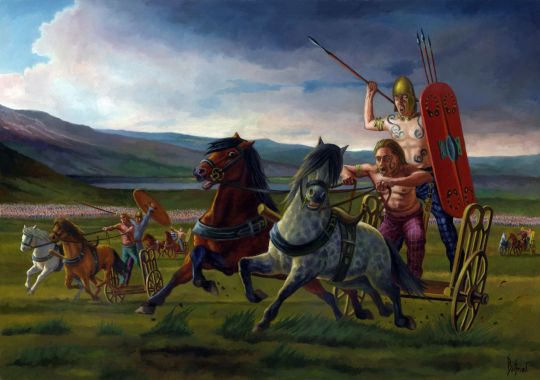
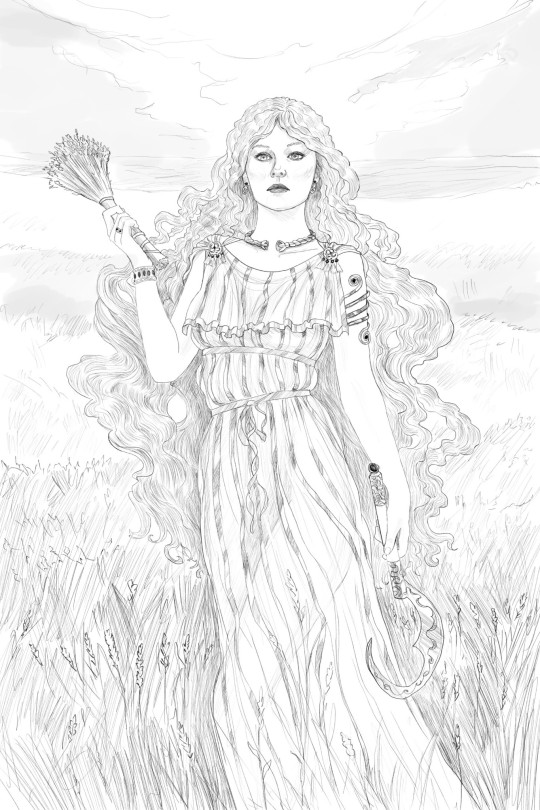
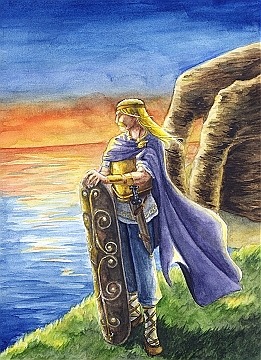
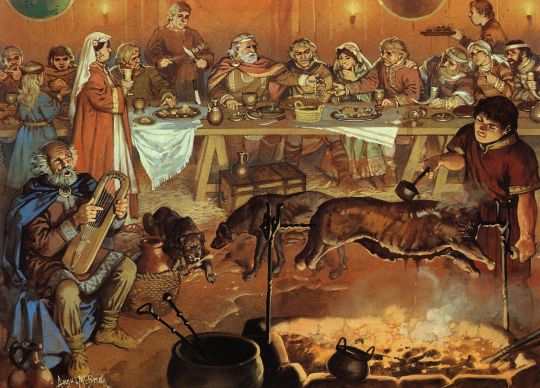
Spelling and Pronunciation
OI. Lughnasadh (Loo-na-sa), sometimes spelled Lughnasa or Modern Irish Lúnasa. Not to be confused with other harvest festivals like Lammas.
Dates
Most reconstructionists celebrate Lughnasadh on July 31st - August 1st from sundown to sundown by the Gregorian calendar, while others choose to celebrate the transitional period between the months as they would have been by the Julian calendar (about 13 days later by the Gregorian calendar).
Traditionally this festival likely would have happened as the grains were ready for harvesting or possibly even when the wild bilberries were ripe (as some scholars mention that if the grains were not ripe they would still preform a ritualized ‘first harvesting’ but it is possible this tradition came after the festival was firmly tied to a calendar date.)
Importance in the Mythos
In the mythologies it is well documented that this festival coincides with Lugh’s funeral games in honor of his foster-mother Tailtiu, known as Aonach Tailteann. In the mythologies she is said to have died of exhaustion after clearing the plains of Ireland for agricultural needs. The first documented instance of Lughnasadh in the mythologies was in the Wooing of Emer, Tochmarc Emire, which makes sense given the importance of marriages at this time of the year. It is not known specifically but widely speculated that the curse of the Ulstermen by Macha took place at a horse race for this festival.
In later time periods it is common to see a form of struggle, normally between the ‘protective’ forces and ‘destructive’ forces. The modern equivalent being the struggle between Saint Patrick and Crom Dubh but this is likely a reflection of an early struggle between Lugh and Balor (which I previously mentioned in my info-dump on Bealtaine).
Celebration Traditions
Aonachs, funeral games, have (to the best of our knowledge) been a custom in Ireland since the bronze age and were practiced on and off into the middle ages. They had both personal and community functions and occurred in three stages. Stage one was the funeral proceedings themselves. They would last one to three days, likely depending on the importance of the individual in question. Mourning songs and chants were participated in by both the attendees and the Druids. The second stage was for proclaiming of laws. Aonachs were a time when universal peace between túaths was declared. The third stage was that of Cuiteach Fuait, games that tested mental and physical abilities. These games included the well known horse and chariot races, wrestling games, boxing, high jumps but also competitions in strategy, singing, story telling and between various skilled craftsmen.
It was incredibly common for marriages to be arranged and preformed during this festival. More well known ‘trial marriages’ (lasting a year and a day) were still preformed at this festival up until the 13th century. It is likely that the coupling occurring at this time of year had an effect on the relationship to births seen at Imbolg (which falls 9 months later).
MacNeill, a leading scholarly expert on the festival, notes that a ritualistic bull sacrifice was made at this festival and the bull would then be eaten. I could not find any definitive evidence to support the idea, but I think it was likely that bulls in general would be culled from the herd at this point in the year to supply the feast.
Art credit @ire-ethereal
My Kofi
#irish#irish mythology#celtic#irish paganism#irish polytheism#paganism#celtic paganism#celtic polytheism#pagan#celtic reconstructionist#celtic reconstructionism#celtic mythology#irish reconstructionism#irish reconstructionist#festival#fire festival#lugh#lughnasadh#Lughnasa#NOT lammas#Tailtiu#harvest#blackcrowing
357 notes
·
View notes
Text
Honouring Tailitu. Part One: Who is She?

Ophelia by John William Waterhouse
During the time of Lughnasadh a lot of focus is placed on the golden boy, Lugh. Which is fair enough, I mean the festival is named for him after all!
Unfortunately, by lavishing Him with all the attention it's easy to neglect the *reason* for the festival- Tailitiu.
Not much is known about Her, but the basic story is more or less agreed upon.
According to the Book of Invasions, Tailitu was the wife of the last Fir Bolg king, Eochaid mac Eirc. Like many others of the time, this marriage was a short lived on. The Tuatha Dé Dannan invaded and his life was lost in the ensuing struggle. However, She was allowed to keep Her land. How nice of them! One good thing did came out of the invasion, the relationship between Lugh and Tailitu. The latter becoming a surrogate mother to the young sun god.
So why is She the reason for the festival?
In order to feed more people, She took it upon herself to clear an area in order to create working arable land. Being an overachiever, She decided to take this on all Herself. Naturally this was all too much. With the tilling of the last field completed She collapsed with exhaustion and sadly passed away.
Once buried, Lugh created a mound over Her grave and ordered fires be lit. In Her honour, He also established the Tailteann Games. A time for honouring the dead, proclaiming new laws and celebrating the harvest. This would commence in the latter part of July and conclude on the 1st or 2nd of August. This became 'Lughnasadh' - the 'assembly of Lugh'. Naturally, She is associated with the land, particularly the area Teltown and the Plain of Brega. Where Her burial mound is said to be and where She is said of plowed the land, respectively.
Stay tuned for Part 2: How to Honour Her!
57 notes
·
View notes
Text
Tailtiu / ティルテュ and Ethnia / エスニア
Tailtiu is the middle child of Duke Reptor of Friege and self-proclaimed bodyguard of Father Claud in Fire Emblem: Genealogy of the Holy War. She is named after Tailtiu, an Irish goddess and wife of the Fir Bolg's final king. After the Fir Bolg were defeated by the Tuatha Dé Danann in the First Battle of Maige Tuired, some sources like the Book of Invasions claim that Tailtiu became the foster mother of the god Lugh. She died of exhaustion after clearing the fields of Ireland for agricultural purposes; her foster son memorialized her by holding the Tailteann Games, an Olympics-esque event held in Teltown - named after the goddess by her husband. This ceremony would evolve into what is now known as Lughnasadh, a Gaelic harvest festival. In Fire Emblem, Tailtiu being on the losing side of history may have been a loose interpretation of the Fir Bolg's loss against the Tuatha Dé Danann. Additionally, her death - her body giving out after years of abuse at the hands of her aunt - seems to have a loose parallel to the goddess dying by pushing her body to her limits. Tailtiu's character also reflects both aspects of the Tailteann Games: her bubbly and energetic personality can be interpreted as a reflection of the celebration and the atheltics of the event. However, the Tailteann Games also mourned not just the death of Tailtiu, but honored all of the fallen. This may have been adapted not just in her own tragic death but in her much more dour mindset following her joining Sigurd's army.
In Japanese, Tailtiu's name is ティルテュ (rōmaji: tirutyu), officially romanized as Tailto. There doesn't seem to be a most common rendering of the name Tailtiu in Japanese, but the two most common forms I've seen are ティルテュ, as seen here, or タルトゥ (rōmaji: tarutu).
Ethnia (JP: エスニア; rōmaji: esunia) is Tailtiu's younger sister and mother of Amid and Linda. Her Japanese name is but one of numerous renderings of Ethniu, also called Ethlinn, the daughter of the Fomorian King Balor kept at the top of a tower to keep her from birthing a prophecized son. Eventually Cían - a member of the tribal rival of the Tuatha Dé Danann - makes his way into the tower, and the two fall in love, though they cannot stay together. Upon the birth of their son Lugh, the child is cast out to sea but manages to survive. The name primarily serves as forming a parallel to Tailtiu, making these sisters named after both Lugh's biological and adoptive mothers. Ethniu also experienced a much more direct tragedy, having to part from her beloved and having her child taken from her and presumed to be dead.
19 notes
·
View notes
Text
Been thinking more about some details of my head canon world-building in To the Limits of Your Choice as I continue outlining it, and I’ve gotten to be a little obsessed with the idea of Crests in their function as blood alien to normal human bodies and anatomy, something that doesn’t always function in a way that is to the physical benefit of their bearer, but that perhaps a little bit of the originating Nabatean’s consciousness is still alive within that blood, within that Crest, and that the way things work out is dependent on the circumstances by which the human forebearer first received the blood and the Crest to begin with.
Cethleann, I head canon as having widely propagated her own Crest throughout the War of Heroes by giving doses of her blood to dying soldiers in order to heal them. It was a gift freely given for no reason other than altruism, and thus the bearers of her Crest rarely experience anything truly detrimental, but there are still certain… effects that make themselves known from time to time. And as Cethleann spent roughly a thousand years in a deathlike sleep as she recovered both from the injuries she suffered at the Battle of Tailteann and from the effects of giving away far, far too much of her blood in that same battle. As her strength waned and she edged closer and closer to the abyss of deathlike sleep, so too did the blood she offered to dying soldiers change in character.
Linhardt is descended from one of those she saved with her blood at Tailteann, and it shows on him sometimes. Being inclined towards healing magic makes him well-suited for Cethleann’s Crest, but he does have certain… symptoms from time to time when the Crest’s power manifests while he’s using healing magic. He can get to be a bit disoriented or it can go as far as him having a bit of an out-of-body experience and feeling mentally untethered from his surroundings, but it rarely lasts longer than a moment, and it’s never painful: the most it does is break his concentration, and deeply unsettle him.
Indech granted his blood to champions who could successfully pass his trials. It was blood willingly given, but always given to warriors, with the assumption that its bearers will often be in battle. Meanwhile, in the present-day, though Bernadetta is certainly jittery as a result of the abuse heaped upon her by her father, but some of her anxiety is due to her Crest at work in her blood, making her hyper-aware of her surroundings, hyper-aware of potential threats—and the anxiety from all of that childhood trauma makes her interpret damn near everything as a threat, and some of the speed with which she runs is due to the Crest at work in her blood, speeding her away from what her mind perceives as a threat. Hanneman, a scholar who is rarely on the battlefield, sometimes has to spend hours at a time pacing in his office to work out ridiculous amounts of excess energy—but when he does take to the battlefield, he never grows tired, and is never weary after battle: indeed, the first few days after a battle are the only times he never finds himself afflicted with that excess energy. And Linhardt’s mother, whom I head canon as possessing a Minor Crest of Indech, who never takes to the battlefield, and never provides the Crest in her blood with any outlet, finds her hands often afflicted with painful spasms when she tries to write.
And then there’s Ingrid with the Crest of Daphnel, the Crest of Daphnel which was obtained by Daphnel by way of murdering the Nabatean originator and defiling their corpse for their blood and the bone which made Lúin. Like all of those who bear the Elites’ Crests, when Ingrid feels the power of her Crest flow through her, it’s not a pleasant experience. Just as I head canon Dimitri’s struggles not to break things thanks to the monstrous strength that is part of his inheritance of the Crest of Blaiddyd as the defiled Nabatean blood in his veins rebelling against his flesh, I head canon Ingrid experiencing more than a small amount of pain whenever the Crest of Daphnel manifests its power. At best, it’s moderately painful, and at worst it’s agony of a kind that makes her feel as though her very blood is on fire within her veins—and yet, she can still think clearly, even in the midst of this agony.
The pain the descendants of the Elites experience in some greater or lesser degree whenever their Crests manifest is not a secret to the nobility. Rhea spun the story that it is a reminder from the Goddess that the descendants of the Elites must wield their power responsibly after the Elites fell to warring in the wake of Nemesis’s death (again, her cover story to explain why all of the Elites died not too long after the war), but she is privately pleased to know that the descendants of those who drank the defiled blood of her dead kin will never be entirely comfortable with that blood running through their veins. There’s the idea that this pain is holy, sanctified, when it’s spoken of at all, anyways—for the most part, it’s become background noise to the nobility, and they rarely speak of it at all.
-
Like a lot of people (at least, I think), I head canon Flayn as being half-human. I think it plays a part in why the Agarthans abducted her in particular; because she is half-human, her Crest is much more easily transmissible than that of her full-blooded Nabatean kindred, and takes hold in human bodies with ease. I head canon her Crest as running extremely true in her descendants, using Hanneman’s assertion that there are others beside her who bear the Major variant of her Crest (Major Crests seem to be extremely rare in Fódlan these days, so for there to be several people who bear the Major Crest of Cethleann that Hanneman can think of just off the top of his head feels significant) as a support, and it has a reputation as being a “devourer” of other Crests. If someone who bears another Crest marries someone who has the Crest of Cethleann, their children will almost always inherit Cethleann’s Crest, rather than the other parent’s, or the Crest of an ancestor further up in the family tree. This, too, may be Cethleann’s will at work within her blood, at least the will that was hers when she gave her blood to those she would—to heal those who are descended from those who received her blood by purging their bloodlines of other Crests, especially those of the Elites.
-
A lot of people have pointed out the significance of Ingrid’s surname being Galatea, and the parallels between her story and that of the Galatea of Greek myth, but something I don’t see discussed quite so often is the potential etymological significance of the name ‘Daphnel,’ whose Crest she bears. Daphnel, I think, most likely ultimately derives from Daphne, who in Greek myth was a naiad who was unwillingly pursued by Apollo, and persuaded her father to turn her into a laurel tree in a bid to escape Apollo’s advances.
In To the Limits of Your Choice, Ingrid has her canonical backstory of having been engaged to Glenn at a very young age, and spending the intervening years between the engagement and Glenn’s death being told that her greatest purpose in life was to love him and become his wife. And as we know, Ingrid’s paralogue involves her only narrowly avoiding being abducted by a man who intended to forcibly marry her. In the post-game sections of the fic, she has escaped all possibility of being married against her will by estranging herself from her family and becoming a knight, a typically masculine role. As Daphne altered her nature in order to avoid unwanted advances, Ingrid has discarded the role society intended her to play to avoid an unwanted marriage. It’s not as extreme as Daphne’s transformation, but it is still a transformation.
Ingrid is someone I consider as having an alienated, downright wounded relationship with her femininity. Forcing herself into traditional femininity doesn’t make her happy—and neither does trying to force herself into traditional masculinity. A clean transformation, one clean choice on either side of the (false) dichotomy, is not something that can ultimately make her happy.
#To the Limits of Your Choice#ncfan's writing process#head canon#Fire Emblem Three Houses#Fe16#Ingrid Brandl Galatea#Linhardt von Hevring
8 notes
·
View notes
Text
SubDublin
A wild hunt rides out tonight
Hate is sallied forth
Troubles now are here again
What did we learn up North?
Send them all underground like the Poddle
“Send them all back” its backing breaking bottles
The ill-thought glow of a public bus in flames
Tear chairs out and carry them up the Gaol
Execute the Gael, upon them seat James.
Ana Livia I live here and could more make
Of breaks spent refusing requests for change
The Green goes red, the red is green, easter egg 1916
Skyline laws and peeling frontages, Blessing basins by ton, and Burgesses
Dublin’s not one for change
The change is never spare.
To do for Dublin, to be its Blake
Garda bike the Liffey takes
Clandestine as a married man’s Fetlife username
Print it all, Ashley Madison, immortalised on Traitor’s Gate
Leon jumped into the Liffey, on its bridge the youth getting lippy
In Garda’s face, he returns the lean projecting strength
Hoping comrades will invade the scene.
The sound of Irish rebellion is a wailed air from a keening woman
The anguished wail of a beauty-leched crone
A blood-bloated battle God whose icon is a crow
The Dwarven rhythm of iron working stone
Rebellion here has a distinctive air
A smell you’d know, an old one, a vintage rare
Wolfe Tones escaping the stout-stripped cheeks of the men who’re there.
Liars light the beacon fires inciting false rebellion
Aren't your countrymen frightened inside? You are, all of you, Trevelyan
No foreign man on Irish shores will loot thy corn for thy family’s stores
Meanwhile on every wall a pale-eyed Eastern gentleman crowned in thorns
Forgiver of forgivers, Enoch that Cain built, Enoch that spoke of rivers, Gods with horns
Riots relish, the city hellish again recalling old destructions; upriver, approaching forms
Drakeprowed viking vessels and direct invited Norman settlers
Arnott’s gutted and cameras culprits spy, what you’d imagine: spides, idlers and should-be-spayeds
We have taken up our hod and spade and ensured that public transport is yonks delayed
We left behind our God and said ‘sure, let’s have something that’s worse instead’
We have always been a mongrel breed, loam bed that rejects no seed.
A country of tall tales, tale tellers talking their tones tuning and tales talling transcendentally
Tall men up north, not quite hyperborean or Pictish but a breed apart, Giant seed
At war their well whetted bodies in violent supremacy the battle ballet, at sport their breathstealing speed
An island of ancient sports and good humoured rough stuff, Tailteann games which bring earthly fames
Men who drain drams and etch out dire dreams, Doirbh agus Draiocht and Craic agus Ceoil
Men who express disbelief through their anuses: “it is in me hole.”
Out with hatemongers down Winetavern street
Into the Liffey, we’ll observe ye all sink
The river that stinks with your blood flows sweet
The soul of the nation is suffering now, I think.
A wild hunt rides out tonight
Hate is sallied forth
Troubles now are here again
What did we learn up North?
2 notes
·
View notes
Text
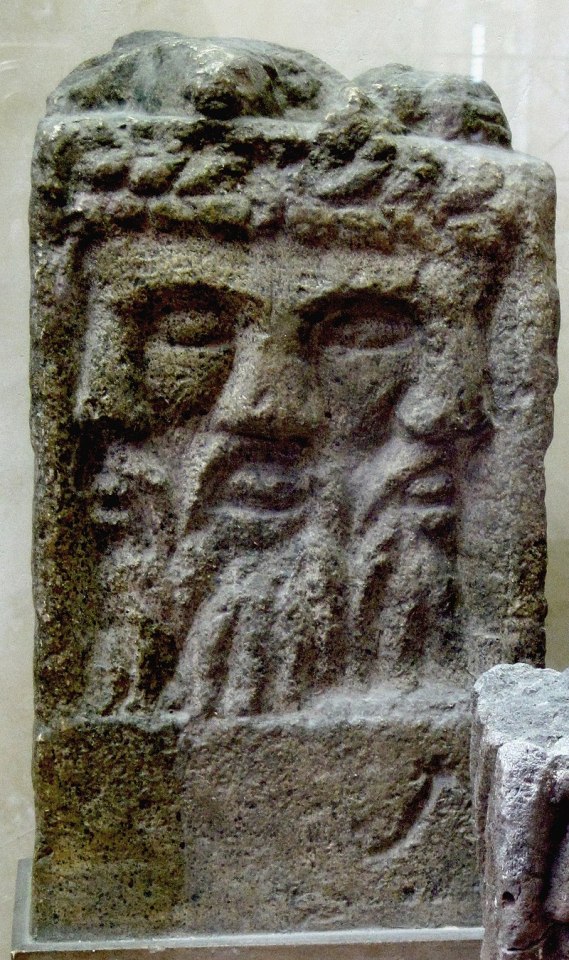
Lughnasadh, Lughnasa or Lúnasa (/ˈluːnəsə/ LOO-nə-sə, Irish: [ˈl̪ˠuːnˠəsˠə]) is an Gaelic festival marking the beginning of the harvest season, and an official holiday in Ireland. Historically, it was widely observed throughout Ireland, Scotland and the Isle of Man. In Modern Irish it is called Lúnasa, in Scottish Gaelic: Lùnastal, and in Manx: Luanistyn. Traditionally it is held on 1 August, or about halfway between the summer solstice and autumn equinox. In recent centuries some of the celebrations have been shifted to the Sunday nearest this date.
Lughnasadh is one of the four Gaelic seasonal festivals, along with Samhain, Imbolc and Beltane. It corresponds to other European harvest festivals such as the Welsh Gŵyl Awst and the English Lammas. Lughnasadh is mentioned in some of the earliest Irish literature and has pagan origins. The festival itself is named after the god Lugh.
It inspired great gatherings that included religious ceremonies, ritual athletic contests (most notably the Tailteann Games), feasting, matchmaking, and trading. Lughnasadh occurred during a very poor time of the year for the farming community when the old crops were done and the new ones not yet ready for harvest.[1] Traditionally there were also visits to holy wells. According to folklorist Máire MacNeill, evidence shows that the religious rites included an offering of the First Fruits, a feast of the new food and of bilberries, the sacrifice of a bull, and a ritual dance-play in which Lugh seizes the harvest for mankind and defeats the powers of blight. Many of the activities would have taken place on top of hills and mountains.
Lughnasadh customs persisted widely until the 20th century, with the event being variously named 'Garland Sunday', 'Bilberry Sunday', 'Mountain Sunday' and 'Crom Dubh Sunday'. The custom of climbing hills and mountains at Lughnasadh has survived in some areas, although it has been re-cast as a Christian pilgrimage. The best known is the 'Reek Sunday' pilgrimage to the top of Croagh Patrick on the last Sunday in July. A number of fairs are also believed to be survivals of Lughnasadh, for example, the Puck Fair.
Since the late 20th century, Celtic neopagans have observed Lughnasadh, or something based on it, as a religious holiday. In some places, elements of the festival have been revived as a cultural event.
2 notes
·
View notes
Text
GAA live: Kerry v Meath, Roscommon v Cork, Dublin v Derry, Galway v Armagh, Laois v Tipperary, Kildare v Dublin, Fermanagh v Sligo, Kildare v Offaly
All-Ireland SHC – Prelim. Quarter-finals: Laois 0-18 Tipperary 3-32 (Full-time) Kildare 0-13 Dublin 3-25 (Full-time) All-Ireland SFC – Round 3: Roscommon 0-17 Cork 0-19 (Full-time) Kerry 0-16 Meath 1-22 (Full-time) Dublin 0-22 Derry 0-20 (Full-time) Armagh 0-27 Galway 2-22 (Full-time) Tailteann Cup – Quarter-finals: Fermanagh 0-21 Sligo 1-16 (Full-time) Kildare 1-17 Offaly 0-19 (Full-time) Ladies…
#All-Ireland Senior Football Championship#All-Ireland Senior Hurling Championship#Armagh#Cork#Derry#dublin#Fermanagh#GAA#Galway#Kerry#Kildare#Laois#LIVE#Meath#Offaly#Roscommon#Sligo#Tipperary
0 notes
Text
Irish Lads Strike Out: Feeley Says Favour Fire’s Burnt Out
...#RásTailteann #CyclingLife #RaceDay #DaireFeeley #IrishCycling #UKWheelbase #CyclingCommunity #RaceTactics #GCContender #CyclingPassion #Sportsmanship #FatherhoodAndCycling #RaceRecovery #CyclingVictories #LegsOfSteel Source link Daire Feeley Reflects on Rás Tailteann: A Tale of Determination and Frustration Daire Feeley’s performance at the 2024 Rás Tailteann was a mix of grit, determination,…
0 notes
Text
Cichol et Liath observaient la plaine de Tailteann, espérant y verser demain le sang de Némésis. Cheveux teints en blond par sécurité, ils portaient tous les deux les insignes d’officiers impériaux. — Cethleann restera à l’arrière pour soigner, annonça le père. Leur fille avait insisté pour venir, même s’ils auraient préféré qu’elle ne participe pas à cette campagne. — Elle y sera le plus utile et puis…si nous pouvons éviter qu’elle ait à se battre, alors c’est le mieux, murmura douloureusement Liath. L’ennemi qui avait transformé leur paradis en cauchemar était tout proche. Seule leur absence leur avait permis d'échapper au massacre. À leur retour, ils s’étaient vus apatrides et orphelins. Liath agrippa la main de son mari. Déterminé, celui-ci la rassura : — Nous allons les vaincre et mettre un terme à cette folie.
1 note
·
View note
Text
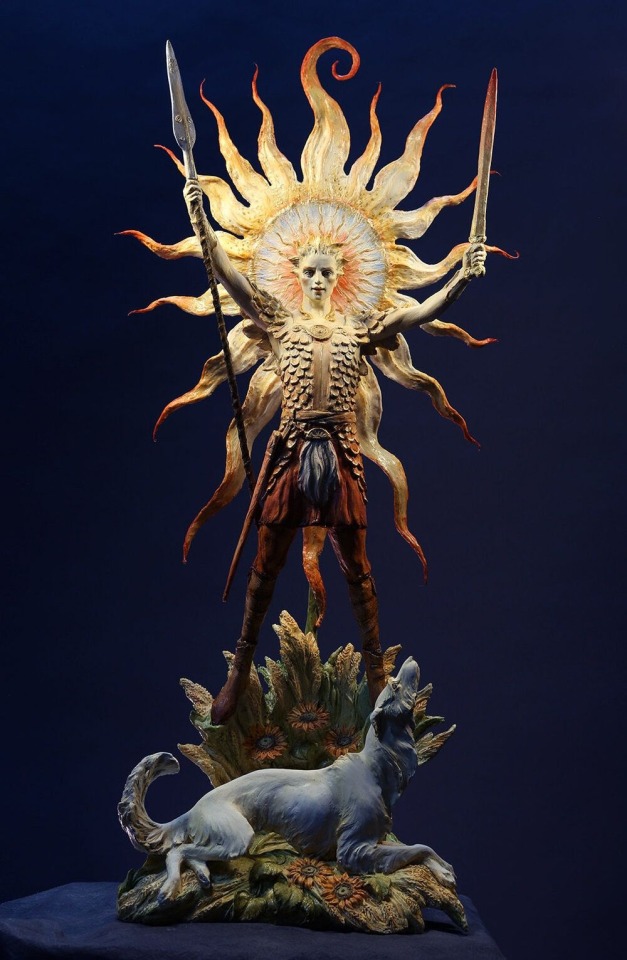
Lugh, of the Light, by Forest Rogers 2020
"Lughnasadh or Lughnasa is a Gaelic festival marking the beginning of the harvest season. Historically, it was widely observed throughout Ireland, Scotland and the Isle of Man. In Modern Irish it is called Lúnasa, in Scottish Gaelic: Lùnastal, and in Manx: Luanistyn. Traditionally it is held on 1 August, or about halfway between the summer solstice and autumn equinox. In recent centuries some of the celebrations have been shifted to the Sunday nearest this date.
Lughnasadh is one of the four Gaelic seasonal festivals, along with Samhain, Imbolc and Beltane. It corresponds to other European harvest festivals such as the Welsh Gŵyl Awst and the English Lammas.
In Irish mythology, the Lughnasadh festival is said to have begun by the God Lugh (modern spelling: Lú) as a funeral feast and athletic competition (see funeral games) in commemoration of his mother or foster-mother Tailtiu. She was said to have died of exhaustion after clearing the plains of Ireland for agriculture. Tailtiu may have been an Earth Goddess who represented the dying vegetation that fed mankind. The funeral games in her honour were called the Óenach Tailten or Áenach Tailten (modern spelling: Aonach Tailteann) and were held each Lughnasadh at Tailtin in what is now County Meath."
-taken from wikipedia
#lughnasadh#celtic gods#celtic mythology#pagan#paganism#sculpture#figurine#statue#celts#celtic#history#art#tailteann#tailtiu#forest rogers
379 notes
·
View notes
Photo

Tailteann, Mabinogi
0 notes
Text
BLACKROCK DART STATION AND NEARBY
The Blackrock baths were provided for by the railway company in 1839 and were built beside the Blackrock train station.

View On WordPress
#blackrock#Blackrock baths#Blackrock Village#Derelict#Derelict Infrastructure#Eddie Heron#Public Transport#Springboard and Highboard Diving Champion of Ireland#Tailteann Games#Thomas Crean
0 notes
Text
Based on how the entire peninsula sreng is on used to be called Sreng, and therefore part of Sreng, and the fact that Fhirdiad is on said peninsula, with text indicating it took time for Fodlan's people to get control of that part faerghus now controls, it is very likely that Fhirdiad was not the original capital of Faerghus, further emphasized by the fact that Kyphon, friend to Loog, had no noble title, indicating Fraldarius didn't control the lands it has today on the peninsula, indicating a war between Faerghus and sreng that leads to House Fraldarius in its modern form getting established. This leaves one other FASCINATING candidate for a capital: Camulus: Camulus is a notable city in Blaiddyd territory located at the Tailteann Plains and is considered a holy site by the church, likely due to being where nemesis dies. It's also worth noting that there is a western, southern, eastern, and central church, but no northern church. one which could have been based in Camulus. As such, it is likely the central church had the north under its direct ecclesiastical influence so as to keep a watch on the core of Nemesis' old empire. This fact, taken with mention of northern swordsmen (gladiators in the original Japanese, indicating that they were slaves) being killed by wild beasts in the entertainment for an Adrestian Emperor's wedding (Emperor Lycaon III in the Feast of Decadence) shows that what is the core of Faerghus, the eastern part of the holy kingdom, was likely under intense domination from adrestia, practically a full-scale military occupation, with slavery being imposed on those who were deemed enemies, whether they were a real threat or not. thereby resulting in Loog, this symbol of chivalry, revolting against adrestian tyranny. However such a revolt comes to include nobles from Mach (western faerghus and adrestia), likely upset over the devastation that is described to have occurred in the region during the war with Dagda. Having Loog rule from Camulus when he becomes king could have been a means of keeping the Kingdom under the watch of the church. The shift from Camulus to Fhirdiad would have been after a war with Sreng and Faerghus that pushes the border further north, with the king moving closer to the new border to keep an eye on the north for Sreng raids. Such raids would be incredibly plentiful as this initial expansion sees Faerghus gain control of the Danu River Basin, in Fraldarius territory, which is the most fertile bit of land in the Kingdom, and thus would be subject to constant raids from Sreng, which has just lost that vital force of agriculture to feed itself, with the rest of Sreng being quite desolate. Later on, we get the Faerghus-Sreng conflict that we see described in three hopes that occurs at the same time as the crescent moon war, which has Conand Tower being built in southern fraldarius (aka where the aforementioned Danu River Basin is) and the deeds of Laetitia Zoe Gautier described in the text leading to House Gautier getting established in the north to guard the frontier, allowing the Kings of Faerghus to divert their attention elsewhere, which results in Faerghus managing to capitalize off the Galatea-Daphnel split by taking half of Daphnel territory and getting a relic out of the deal.
Thought I wrote this about Church-Kingdom relations already but apparently I didn't, so:
I think the initial reason the Church got so close to Faerghus might not have been because they were seen as good trustworthy allies. Rather, it's because they were seen as a suspicious lot who needed to be kept on a tighter leash than the Empire. Similarly, the Kingdom's initial reason for getting close to the Church was also for political and military interests and not piety.
For why the Church wouldn't like the Kingdom at first, consider how this began. In 747, there's a rebellion up north in Faerghus. The culprit is Loog, a descendant of an Elite, aka descendant of the Empire's old enemies. It appears that Agarthans were involved in this.
This doesn't exactly look like a conflict where Church and Rhea would want the rebels to win; it's literally their old foes teaming up again. They probably would have accepted (and even wanted) Adrestia crushing and putting them under imperial rule again.
But things don't resolve that easily— maybe because the Empire depleted much of their resources on the war against Brigid and Dagda not so long ago. The rebellion began in the northern part among descendants of Elites, but as time goes on even the western (Mach) lords are rugpulling the Empire and siding with Faerghus. Then the Empire loses at Tailtean.
At this point, it's pretty damn clear: the rebels will not accept being under Adrestian rule again. So what's Rhea and the Church to do, when there's about to be Agarthan Puppet State 2?
My theory is that they decided to keep their friend close and enemy closer.
The Church tells the rebels, okay, no more war, we got the message. You guys can have your own state and we will recognize and legitimize it, as long as you make this faith your official religion (=be close to us, not the Agarthans). Sound good?
The rebels... probably think that this is sus, too. After all, at that point the Church and Empire must still have been each other's strongest allies. What does the Church have to gain by suddenly rewarding them for the rebellion? But, well, power is power, goal accomplished is goal accomplished. So they accept, and the Holy Kingdom of Faerghus us established.
(And the Empire probably wasn't pleased about all this, but hey, Church thinks it's still better than having Agarthan Puppet State 2. Not that they would have explained those details to Adrestia.)
Onto another factor that makes Church's relationship to the Kingdom different from Empire, and yet another reason the Church would want to keep a closer eye on the former: Relics.
Again, given the descendants of Elites thing, Rhea must not have been too keen on giving Kingdom the Relics at first. And I say "give," because early in Kingdom history, the Church would still have some/most of the Relics they got after hunting down the Elites.
In the very least, we know the Lance of Ruin was under Church custody until 896:

Given the context, I think the Church initially gave the Relics back only if the houses could give a legitimate (from Fódlani POV) reason (+maybe if the Crest-bearer demonstrated that they were faithful and promised to use it properly).
Now, in paralogues where you get the Relics, there are multiple mentions of those being passed down families for generations. If the above is true, I think this could indicate any combination of:
somehow every single house managed to demonstrate their piety/necessity of the Relic
the Church's wariness loosened a while back and they grew more chill about giving them Relics
at some point the Church decided that letting them have Relics was better than another option (Ex: they go seeking Agarthan help instead)
Right, so that might be the Church's POV on Relic ownership and use. What's the Elite descendants' POV?
First, note the word "reclaimed" in that entry above, and then this:

"Lost our Relic to the church." Also "afraid that the church would try to keep the lance" is actually more along the lines of "afraid the church would try to take/steal(!) the lance away" in Japanese. They think the Relic is theirs.
Back to the Church real quick, this happens if you refuse to return the Lance of Ruin after the Miklan chapter:
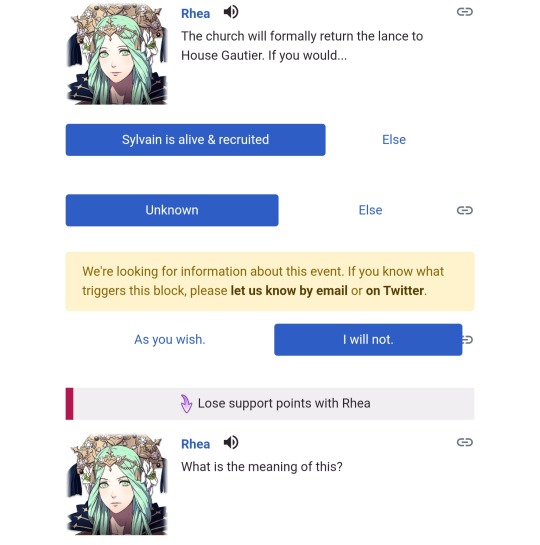
Even if the Relic ends up with the noble house anyway, the Church still wants to oversee/be in charge of the process.
In other words, the Church and Elite houses might be like
Church: Remember, we're letting you have this.
Nobles: ? No it's just ours, period.
about Relics.
Not to mention, for all the emphasis Rhea and Church puts on the Relics being holy gifts from the goddess, none of the Elite descendant students mention that or treat them with religious reverence after the paralogues. They're more like, hey check out this powerful weapon our family has, can you keep an eye on it Professor, thanks.
Maybe that's also because after generations of keeping the Relics, they simply don't think too much about it anymore. Maybe the generation that got it back was more pious in a way that convinced the Church it was okay to let them have it (and/or had a legitimate reason like Laetitia).
Or maybe, the Kingdom's (+maybe Alliance's while they were a part of the Kingdom) primary motivation for being close to the Church was always about politics, legitimacy, and getting their Relics (military power) back, not piety or ideological alignment.
Granted the religiosity of the population could eventually have become another legitimate factor, and perhaps by the canon era a portion of the Faerghans genuinely believe in "we're close to the Church because we're grateful for what they did to us and as honorable knights we repay our debts (regardless of our personal religiosity)" after repeating that excuse(?) for generations.
But I don't think the earlier generations were like that, and I especially don't think the founding generation (Loog and co.) was like that. You can't raise a new kingdom and maintain it on vibes, you need power, and by god these Elite descendants were going to get their greatest source of power back no matter what. What's paying a little lip service and LARPing piety 24/7 if you can get literal handheld nukes in exchange?
Similarly, what's putting up with descendants of people who traumatized you swinging around your dead relatives that's somehow the least bad option that stops them from seeking worse things and ruining even more lives?
(Aside from the country ruled by the descendants of your allies becoming an Agarthan puppet state while you weren't paying attention.)
Tl;dr what if the Vatican could give you nukes so you converted to Catholicism and made it the state religion
(Also you think the nuke they gave you is yours in the first place because your ancestors used it before the Vatican took it, but the nukes actually are made of the pope's dead relatives so she may disagree with you there, even if she doesn't outright say it because she's afraid of you inventing a death ray if you're not allowed to have the nukes)
#fe3h#fe3h worldbuilding#fire emblem three houses#fe3h meta#church of seiros#faerghus#holy kingdom of faerghus#rhea#rhea fe3h#rhea fire emblem
15 notes
·
View notes
Text
Thrilling Finish: Stage 2 Tailteann Race from Charlestown to Clifden – 170.9km of Heart-Pounding Action!
...#RaceTailteann2025 #CharlestownToClifden #TailteannStage2 #M170.9KMChallenge #IrishCyclingRaces #ClifdenCyclingEvent #TailteannRaceLegends #BikeRaceIreland2025 #RaceTailteannPromotion #CyclingRoadToClifden #IrishCyclingStage2 #RaceTailteannHighlights #CharlestownCyclers #ClifdenBikeRace2025 #TailteannLegacyRace #IrishCyclingJourney #Tailteann2025Participants #UltimateCyclingChallengeIRE…
0 notes
Text
The Aonach Tailteann Games
The Aonach Tailteann Games
When Lammas, or Lughnasadh, rolls around at the beginning of August, it’s often a time for local festivals, country fairs, and harvest events. Believe it or not, this isn’t a new tradition at all. The Aonach Tailteann was a fair held by the High Kings of Ireland in County Meath, and some early historians believe it originated during prehistoric times. Also spelled Óenach Tailteann, this fair was…
View On WordPress
3 notes
·
View notes